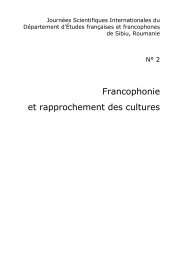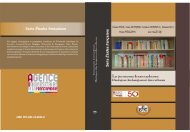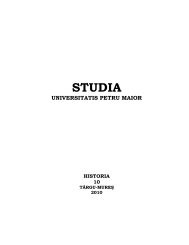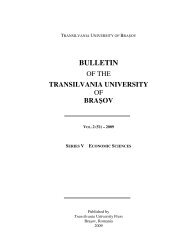„ovidius†constanţa - Biblioteca Universitatii "LUCIAN BLAGA" SIBIU
„ovidius†constanţa - Biblioteca Universitatii "LUCIAN BLAGA" SIBIU
„ovidius†constanţa - Biblioteca Universitatii "LUCIAN BLAGA" SIBIU
Create successful ePaper yourself
Turn your PDF publications into a flip-book with our unique Google optimized e-Paper software.
Analele Universităţii „OVIDIUS” – Seria Istorie<br />
Volumul 4, 2007<br />
MONEDA CU DOUĂ FEŢE: FEDERALISMUL CENTRAL-<br />
EUROPEAN ÎN CONCEPŢIA ELITELOR POLITICE<br />
INTERBELICE<br />
Drd. Daniel CITIRIGĂ �<br />
The Faces of the Coin: Central-European Federalism in Inter-War Political Elites<br />
Abstract: A comprised analysis of the most important political characters of Central<br />
Europe as regards the issue of federalism emphasizes at least two well-defined trends:<br />
on one hand, if we take into consideration the geographical aspect, the elites of the<br />
former Austro-Hungarian Empire operate a State perspective having as basis federal<br />
principles, while on the opposing side upholders of centralism are to be found. The<br />
paradox appears due to the political culture that was the basis for the maintainers of<br />
federalism theories. From a different perspective it is important to underline the fact<br />
according to which the reasons for the analysis of federal structures differ depending on<br />
the new condition of the involved state at the end of the First World War: the defeated<br />
states had as target the maintaining of certain “sacred” territories, while the victorious<br />
ones aimed either the remaking of ancient entities or sought a defensive method for the<br />
external threats or, why not the territorial expansion under what can be named “small<br />
powers imperialism”.<br />
Keywords: federalism, elites, Central Europe, nationalism<br />
Pornind de la premisa că definirea Europei Centrale reprezintă obiectul<br />
unei îndelungate controverse ştiinţifice şi politice am organizat acest studiu pe<br />
spaţii geopolitice/statale. Nu am considerat necesar, însă, să eliminăm cazurile<br />
de întrepătrundere fenomenologică. În acest context, este obligatoriu să<br />
precizăm că am optat pentru formula geopolitică a Europei Centrale care se<br />
referă la spaţiul dintre Germania şi Rusia, fără Austria, pe care am considerat-o<br />
după Primul Război Mondial drept obiect al sferei de influenţă civilizaţională<br />
germane.În ceea ce priveşte o viziune proprie asupra federalismului centraleuropean,<br />
este necesar să subliniem că numărul personalităţilor impresionează ci,<br />
în special, poziţia lor politică.<br />
Elitele politice interbelice implicate în proiectele de federalizare a<br />
spaţiului central-european provin, în general, din două spectre diferite: primul<br />
remarcat de noi ar fi cel format din state precum Iugoslavia, România sau<br />
Cehoslovacia care urmăreau prezervarea noilor teritorii, iar cel de-al doilea de<br />
state precum Ungaria sau Polonia care vizau refacerea statalităţii medievale.<br />
� Asist.univ.drd. Facultatea de Istorie şi Ştiinţe Politice, Constanţa.<br />
ISSN -1841-138X 7 © 2007 Ovidius University Press









